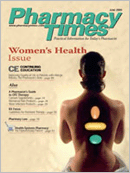Publication
Article
Pharmacy Times
Consensus Guidelines for Hormone Therapy
Author(s):
Universally hailed just 10 years ago as a 20th-century elixir for health promotion and disease prevention in women, hormone therapy (HT) is now the subject of intense, contentious debate. Scrutiny has shifted from positive impacts of HT to its negative outcomes, and the subject is replete with conflicting research findings.
Professional groups have attempted to quell stormy rhetoric by issuing consensus guidelines, revising them quickly as new research findings emerge. The North American Menopause Society (NAMS), for example, issued its first position statement for HT in 1998,1 with revisions in 2002,2 2003,3 and 2004.4 The Institute for Clinical Systems Improvement (ICSI), an independent, nonprofit organization that provides health care quality-improvement services to 54 medical organizations representing >7400 physicians, first issued guidelines in 1999. Its 7th revision is imminent.5 These welcome but frequent revisions suggest how little is known about the complex interplay between HT, health, and disease etiology.
Consensus guidelines are not evidence-based standards, and the distinction is important (see sidebar: Standards, Guidelines, and Options). Guidelines are more flexible and accommodate case-bycase differences.
North American Menopause Society
In its most recent position statement, a NAMS consensus panel reached consensus on >20 treatment recommendations for postmenopausal HT, including uniform terminology for menopauserelated therapies (Table 1). The NAMS guidelines are available at http://www.menopause.org.
The NAMS guidelines consider patient age and treatment duration. Risk/benefit assessment must incorporate family history and the patient's own risk indicators and values. Prescribers should counsel women, because many may find it difficult to place risk and benefits into proper perspective. Table 2 summarizes NAMS'position on several key points.
The NAMS experts have concluded that extended use of the lowest effective dose of estrogen or estrogen-progesterone therapy is warranted for menopause symptom relief if benefit outweighs risk. It is warranted particularly when HT withdrawal has failed; when moderate-to-severe menopause symptoms occur in women with high osteoporotic fracture risk; and for bone-loss prevention in women with demonstrated bone loss who are inappropriate candidates for alternative therapies.4
The Institute for Clinical Systems Improvement
The ICSI's "Menopause and Hormone Therapy: Collaborative Decision- Making and Management" publication (http://www.icsi.org) is highly recommended, complementing the NAMS position statement nicely. The ICSI publication augments its clinical guidelines with lifestyle modifications; discusses the effectiveness of alternative treatments, including herbal and dietary supplements; and provides practitioners and consumers with a decision-making algorithm. Regarding alternative treatments, the ICSI notes, for example, that two thirds of women taking selective serotonin reuptake inhibitors at low doses have had vasomotor relief, compared with one third taking a placebo.5
The ICSI advocates health monitoring for rapid bone loss when long-term users discontinue HT. All women, regardless of treatment choice, should be periodically reevaluated for risks, benefits, and contraindications (Table 3). Despite practitioner reluctance to prescribe HT for patients with certain clinical conditions, the ICSI notes that HT is not contraindicated for patients with endometriosis, fibrocystic breast disease, hypertension, mastalgia, migraine headaches, obesity, tobacco use, and uterine fibroids.
Recommendations Lacking Consensus
Expert consensus panels have failed to reach agreement in 4 areas. This lack of consensus complicates decision making, but insufficient evidence and/or conflicting research findings make certainty elusive. The unanswered questions are as follows:
- Is early increased coronary heart disease risk associated with HT?
- Should long-term HT be discontinued for women who are doing well on it?
- What is the best approach to discontinuing HT?
- Are different effects associated with continuous-combined estrogen- progestogen therapy and continuous- sequential estrogen-progestogen therapy?4
These questions represent research priorities, including the impact of HT on psychological well-being and quality of life.
The Need to Begin Decision Making Early
Each day, ~4000 US women reach menopause, and by 2020, ~40 million women will be perimenopausal.4,5 Experts recommend initiating menopause and HT options discussions at age 40, encouraging women's participation in decision making about alternatives for menopausal-symptom relief, and guiding their risk/benefit analysis of long-term and short-term HT.5 Counseling must emphasize that risks and benefits are not well-defined, and definitive information is lacking.5 Until experts promulgate evidence-based HT standards, frequent guideline revisions should be expected. When to start, modify, and discontinue HT are treatment questions with endless answers.
Standards, Guidelines, and Options6,7
Standards are medical practices linked to well-defined outcomes supported by high-quality research and clinical trials. Practice standards are followed in almost every case; deviations are rare and must be justified. Guidelines generally are associated with predictable outcomes, but circumstances exist where different outcomes might be expected. Guidelines represent a lower degree of certainty, and deviations are common in response to individual circumstances. Options are opinion-based practices yet to be supported or disproved by research.
Dr. Zanni is a psychologist and health-systems consultant based in Alexandria, Va.
For a list of references, send a stamped, self-addressed envelope to: References Department, Attn. A. Stahl, Pharmacy Times, 241 Forsgate Drive, Jamesburg, NJ 08831; or send an e-mail request to: [email protected].

Newsletter
Stay informed on drug updates, treatment guidelines, and pharmacy practice trends—subscribe to Pharmacy Times for weekly clinical insights.






